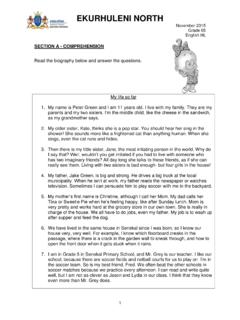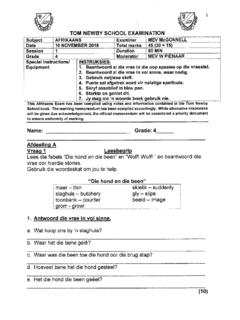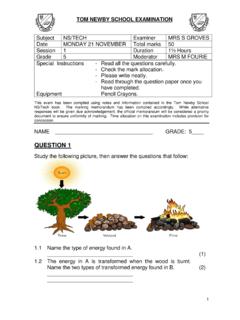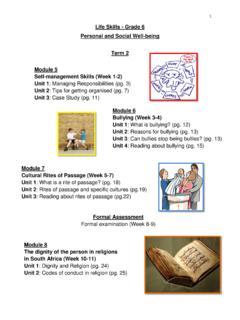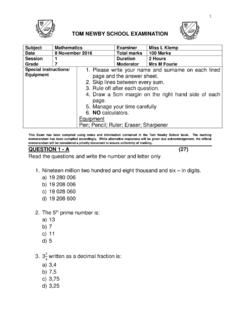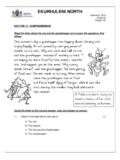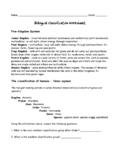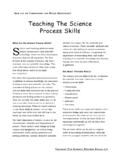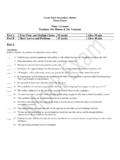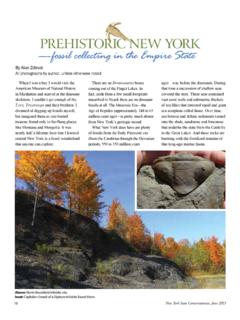Transcription of Natural Science and Technology Grade 5 2016
1 1 Natural Science and Technology Grade 5 2016 2 Term 1 Life and living and structures Contents Topic 1 Plants and animals on Earth Unit 1: Different plants and animals - pg3 Unit 2: Interdependence - pg6 Unit 3: animal types - pg9 Topic 2 animal skeletons Unit 1: Skeletons of vertebrates - pg11 Unit 2: Movement - pg13 3 Topic 3 Skeletons as structures Unit 1: Frame and shell structures - pg15 Topic 4 FOOD CHAINS Unit 1: Food and feeding - pg17 Unit 2: How a food chain works - pg20 Topic 5 LIFE CYCLES Unit 1: Growth and development - pg21 Unit 2: Plant life cycles - pg23 Unit 3: animal life cycles pg24 Topic 1 Plants and animals Unit 1 Different plants and animals 4 The biodiversity of the Earth is made up of all the plants and animals, and their habitats.
2 Habitats are Natural homes for plants and animals. Animals and plants have special features to survive in their habitat. South Africa has a wide variety of indigenous plants and animal . The plants and animals have always lived and survived in a particular area. A. Plants grow in different habitats Water lilies grow in water. The leaves are large and flat and float on water. Aloes live in dry areas. Their leaves are thick and fleshy and store water. Key Words habitat - the Natural home of a plant or an animal biodiversity the variety of all the plants and animals on Earth indigenous plants and animals that have always lived in a certain area shelter a place that gives protection from bad weather and danger 5 Activity 1 Redraw the following table in your workbook.
3 List 3 other indigenous plants, their habitats and how they have adapted to that living environment. An example has been included to assist you. Plant Habitat Adaptation Example: Rooibos plants Dry, sandy soil The leaves are thin and small. Less water is lost from the leaves. A. Animals live in different habitats Habitats are places where animals and different organisms get there food, water, air and shelter. Shelter protects animals against their enemies as well as the weather elements. Toucans live in forests They have small wings to easily fly through the branches and leaves of the rainforest trees. Zebras live in grasslands. The white stripes on their bodies, temporarily blind their predators when they run away from them. 6 Activity 2 Redraw the following table in your workbook. List 3 other animals, their habitat and how they have adapted to that living environment.
4 An example has been included to assist you. Plant Habitat Adaptation Example: Fish Water Gills are used for breathing. Fins are used for movement. Unit 2 - Interdependence Key Words interdependence is when living and non- living things depend on each other for survival. ecosystem areas where certain types of plants and animals live .In these areas they depend on each other as well as non- living things to survive. 7 A. Interdependence between living things 1. Interdependence and feeding Animals depend on each other for food. Included are the following groups: a. Herbivores eat plants. b. Carnivores eat other animals. c. Omnivores eat both plants and animals. d. Scavengers feed off dead animals and plants. e. Decomposers eat and break up dead animals and put the chemicals from their bodies (carbon, phosphorus and nitrogen) back into the soil to feed the plants.
5 2. Interdependence and pollination We call animals that pollinate flowers pollinators. Plants produce nectar that attracts pollinators. However, it could also be a special smell or a bright coloured flower that attracts them. Animals use pollination for reproduction. 3. Interdependence and seed dispersal Plants make the fruit sweet and tasty, so that animals eat and excrete the seed. Seed could stick to the animal s fur as well. In these ways the animal assists the plant in dispersing the seed. Bees are excellent examples of pollinators Birds are excellent examples of animals that disperse seed 8 Interdependence between living and non- living things Living and non- living things depend on each other in an ecosystem. The following table shows the relationship between living and non-living things. NON-LIVING THING FUNCTION Shelter Protection from predators or weather. Air Oxygen, either from the air or dissolved in water, is required for respiration.
6 Water All living things require liquid water. Food Al living things need food for energy. Space Space is needed for food, water, shelter and reproduction Water and oxygen are extremely important for all living things. Water that we drink is part of a gigantic system called the Water Cycle. Activity 3 Carefully draw and label the Water Cycle. Ensure that the following labels are included: Evaporation Condensation Precipitation Freezing Melting Run off 9 A. Animals without bones- Exoskeletons Some animals have no bones at all. These animal s bodies are covered and protected with a hard exterior layer called an exoskeleton. Animals with exoskeletons are called invertebrates. Exoskeletons are plates joined together to make hard shells. The only soft parts are at the parts where the body bends, e g. the leg. These animals have to moult to grow. Unit 3 animal types Key Words Exoskeleton - the shell or hard covering on the outside of animals.
7 Endoskeleton - a skeleton found inside of an animal s body. Invertebrate - an animal that does not have a backbone made of bones. Vertebrate - an animal with a bony backbone . Moult - to shed the outer covering of the body and to grow a new, bigger one. Cartilage - flexible, tough substance that cushions bones at the joints Features - important or noticeable parts of something 10 The six groups of invertebrates Group Name Examples Sponges Sponge Jellyfish Jellyfish, anemone Worms Earthworm, flatworm Molluscs Snail, octopus Starfish Starfish, sea urchin Arthropods Spider, crab Sea sponge Anemone (Say: an air moan ee) Snail Starfish Jellyfish Flatworm Sea urchin Crab Snail 11 B. Animals with bones Endoskeletons Some animals have backbones made of small bones called vertebrae. These animals are called vertebrates. A frame structure made of bone and cartilage is called an endoskeleton. The skeleton is covered by muscles and soft body tissue.
8 The animal is able to grow without having to moult. The five groups of vertebrates Group Name Examples Mammal Elephant, human, rat Birds Blue crane, ostrich Fish Shark, surgeon fish Amphibians Frog, newt Reptiles Snake, crocodile Activity 4 Find and paste at least two pictures of each vertebrate group in your class work book. Topic 2 animal skeletons Unit1 Skeletons of vertebrates 12 Skeletons of vertebrates Skeletons support and give shape to the body. They protect the soft organs of the body. The skeletons of vertebrates are made of bones and cartilage. Cartilage is found at the joints. Cartilage is a tough, flexible substance that allows bones to rub together smoothly without causing pain. Joints are places in the body where the bones meet. Bones Bones are hard and form a very strong frame structure to support and protect a vertebrate animal s body.
9 The functions of the bones: 1. The skull - Protects the eyes, ears, nose, mouth - Protects the brain - Teeth and the lower jaw are also attached to the skull Key Words vital organs organs in the body that are absolutely necessary for life limb body attachments such as legs, arms or tails joint place where two or more bones meet skull (cranium) head bone that protects the brain backbone (spine) the backbone that stretches from the skull to just below the hipbone. shoulder blades (scapular) upper limbs (arms) are attached at the shoulder blades ribs joint to the spine to form a rib cage around the chest area. hip bone (pelvis) the lower and back limbs (legs) are attached at the hips 13 2. The spine - Made up of vertebrae - A hole runs through each vertebra.
10 - The backbone has two functions: a. It protects the spinal cord with all the nerves vessels in it. b. It supports the upper body. 3. The ribs - Where the ribs are in the chest area, it protects the lungs, heart and other important organs. - In snakes, the ribcage can protect and support the whole body. 4. Shoulder blades, hip bones, arms legs - The upper limbs (arms) are attached to the body at the shoulder blade - The lower limbs (legs) are attached at the hips. Unit 2 Movement in vertebrates Key Words muscles masses of tough elastic tissue that pull our bones when we move tendons tough cords that attach muscles to bones ligaments bones that connect bone to bone and strengthens the joint adaptation changes in a body over time to suit the environment 14 Bones are very hard and cannot bend, yet your body can move in many ways.
